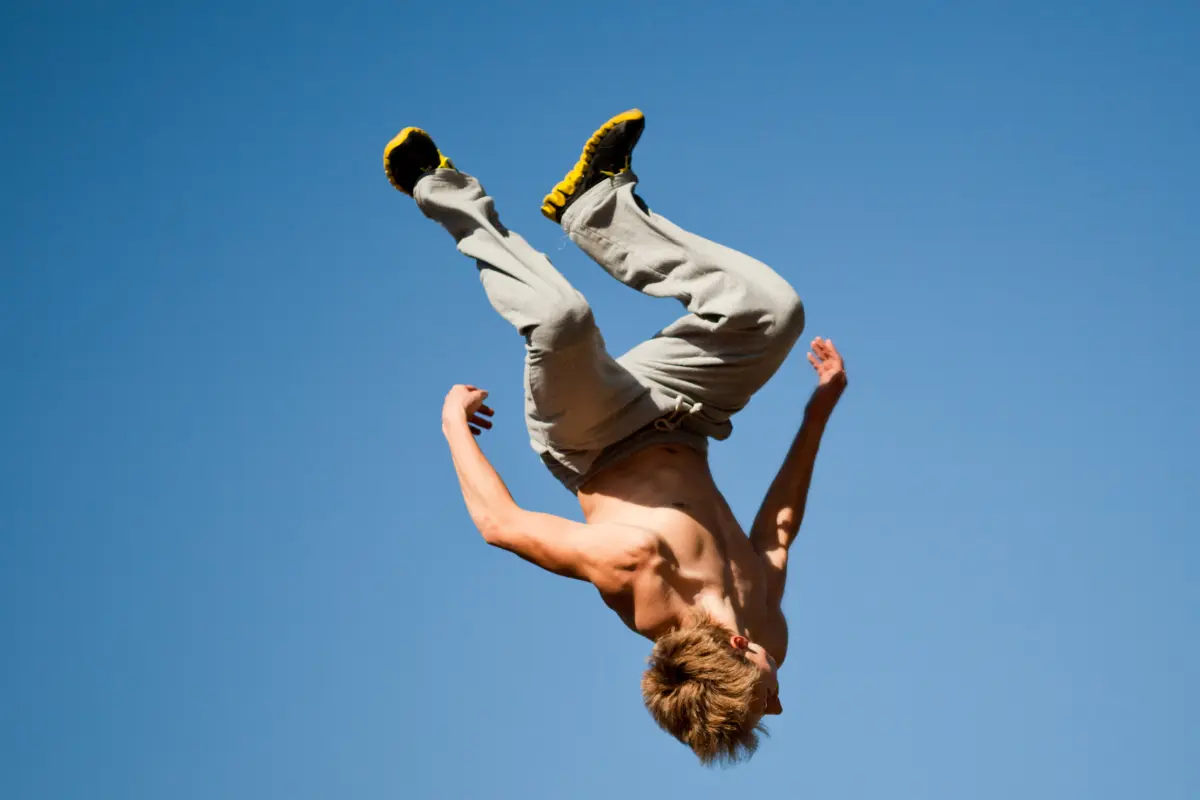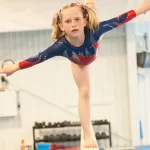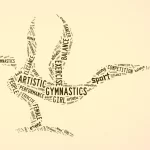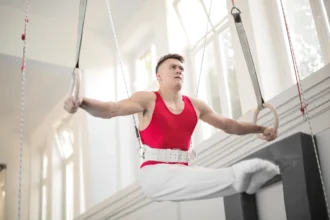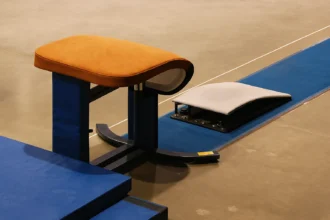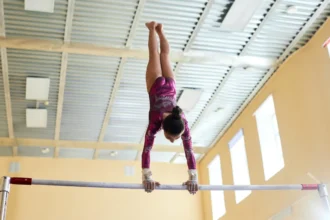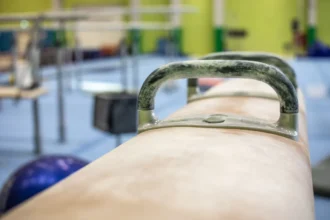In gymnastics, a “salto” refers to a complex acrobatic move involving a gymnast performing a somersault or flip in mid-air. Derived from the Italian word “salto,” meaning “jump” or “leap,” the salto is often a key element in both floor routines and vaulting, and it showcases a gymnast’s aerial ability, strength, and control.
Historical Background of the Salto
The term “salto” is derived from the Latin word saltare, meaning “to leap.” This acrobatic move began to take shape in the 19th century. By the mid-20th century, the salto had become a cornerstone of gymnastics routines, particularly with the growth of televised competitions.
Gymnasts like Olga Korbut and Nadia Comaneci popularized more complex salto moves in their Olympic performances in the 1970s.
By the 1990s and early 2000s, gymnasts like Simone Biles were pushing the limits with incredibly difficult variations, such as the Biles—her signature double-twisting double backflip, which set a new standard in gymnastics.
Key Elements of a Salto
The successful execution of a salto relies on several key elements:
Body Position: The gymnast’s body position during the salto is crucial for its execution and difficulty. The main body positions are:
- Tuck: The gymnast pulls their knees into their chest, creating a compact shape. This position allows for faster rotation and is often used for simpler saltos or when learning the move.
- Pike: In the pike position, the gymnast bends at the hips with straight legs, creating an “L” shape. This position makes the salto more difficult because it slows down the rotation.
- Layout: In the layout position, the gymnast keeps their body straight from head to toe. This position requires a high level of control and strength and is typically used for more advanced saltos.
Takeoff and Aerial Phase: The takeoff for a salto must be explosive to generate enough upward momentum for the rotation. Gymnasts use their arms and legs efficiently, with a controlled push-off from the apparatus. During the aerial phase, it’s essential to maintain body tightness and precise rotation to complete the salto successfully.
Landing: A safe and controlled landing marks the final phase of the salto. Gymnasts need to keep their body in the correct position to absorb the impact and stay balanced. A soft, controlled landing is expected, with the feet landing first and the body remaining upright.
Complexity and Variations
SSaltos can be made even more challenging by incorporating twists. The number of twists can vary, significantly increasing the difficulty of the move. For instance, a “full-in, back-out” involves a double salto with a full twist performed during the first salto, creating a spectacular, high-difficulty element.
As gymnasts progress in skill level, they may perform multiple saltos in succession, such as double or triple saltos, often combined with twists. The more twists or rotations included, the higher the difficulty score for the routine.
There are several variations of the salto, each distinguished by its rotation and the body position during the movement. The most common types of salto in gymnastics include:
1. Forward Salto
The forward salto, also known as a front flip, is performed by rotating forward. The gymnast typically pushes off the floor or apparatus with their legs, tucking their body into a ball to rotate faster. A successful forward salto finishes with the gymnast landing on their feet.
Example in gymnastics: The front handspring is a common example where a gymnast performs a forward salto as part of a floor exercise or vault.
2. Backward Salto
The backward salto, or backflip, is executed by rotating backward. The gymnast takes off, leans backward, and tucks their body to create the rotation needed to flip over. The backflip is a more difficult skill for many gymnasts due to the need for precise body control and timing.
Example in gymnastics: A back handspring is a common move where the gymnast pushes backward into a back salto.
3. Layout Salto
A layout salto refers to a somersault performed with the body fully extended, without tucking or bending. The gymnast maintains a straight body throughout the rotation, requiring a high level of strength and control to avoid any deviation in their body position during the flip.
Example in gymnastics: A layout backflip on the floor is a common display of this skill.
4. Tuck Salto
The tuck salto involves the gymnast pulling their knees into their chest during the somersault, which increases the speed of the rotation. This is the most common form of salto for gymnasts of all skill levels since it provides the necessary speed and control to complete multiple rotations in mid-air.
Example in gymnastics: A tuck backflip is often seen during both floor routines and vaulting.
5. Twisting Salto
A twisting salto combines a somersault with a twist in the air. It is one of the most difficult forms of salto, as it involves not only rotating but also turning the body around its axis. The gymnast must have strong spatial awareness and timing to execute the twist correctly.
Example in gymnastics: The Biles (a double-twisting double backflip) is a highly complex twisting salto performed by Simone Biles.
The Most Dangerous Salto: Thomas Salto
The Thomas Salto is a complex and dangerous gymnastics skill named after American gymnast Kurt Thomas, who popularized it in the late 1970s. This move involves a 1.5 backward salto with 1.5 twists, followed by a forward roll-out.
While spectacular, the Thomas Salto has been banned in both men’s and women’s gymnastics due to its high-risk nature. The move requires the gymnast to land from a somersault with multiple twists, which can result in an uncontrolled landing and increase the risk of severe injuries, including spinal cord damage, concussions, and neck injuries.
A tragic example of this occurred when Soviet gymnast Elena Mukhina attempted a similar move, the Thomas Salto with a full twist, resulting in a neck injury and subsequent paralysis. In response to these incidents, the International Gymnastics Federation (FIG) banned the Thomas Salto to promote safety and prevent further accidents.
Salto in Different Gymnastics Events
The salto is used in all gymnastics events, but how it’s performed can vary depending on the event. Here’s how it’s incorporated:
Floor Exercise
On the floor, a salto is often the highlight of a gymnast’s tumbling pass. It’s challenging because the gymnast needs to jump high and rotate without using any apparatus. Gymnasts perform different types of saltos, like tuck, pike, and layout saltos, and combine them with other skills like back handsprings or round-offs. The most difficult routines can include double or triple saltos.
Vault
In vault, the gymnast runs, jumps off a springboard, and performs a salto over the vaulting table. Vaults often include twists along with the salto. A gymnast might start with a round-off or handspring to help set up the salto. More advanced vaults, like the Yurchenko, involve a round-off onto the table followed by a salto with a twist in mid-air. These moves require explosive power and good timing.
Uneven Bars
On the uneven bars, saltos are used when transitioning between grips or for dismounts. The gymnast swings, lets go of the bar, does a salto (often with a twist), and lands either on the mat or the other bar. Famous skills like the Healy or Jager incorporate salto elements. These moves require strong control and the ability to generate enough rotation for a smooth landing.
- Balance Beam
On the balance beam, gymnasts use saltos in acrobatic series or as dismounts. Saltos can be performed alone or as part of a combination of skills. Because the beam is narrow, saltos on it require extra control and balance. Common moves include tuck and layout saltos, which require precision as the gymnast rotates in the air while staying balanced on the beam.
Is a Salto the Same as a Somersault or Flip?
A salto is similar to a somersault or flip, but there are some differences in gymnastics terminology.
- Somersault: This term is commonly used to describe a full rotation of the body in a head-over-heels motion, usually without twists. It’s a more general term for any forward or backward flip.
- Flip: This is another term often used interchangeably with somersault, but it can also refer to any acrobatic maneuver where the gymnast rotates in the air, whether forward, backward, or with twists.
- Salto: In gymnastics, a salto is specifically a somersault, but the term tends to be used more formally for the rotational part of acrobatic skills. A salto may be performed with or without twists, and it’s often used to describe more complex variations in routines.
So, while all saltos are flips or somersaults, not all flips or somersaults are called saltos. The word “salto” is typically reserved for gymnastics and acrobatic contexts.


